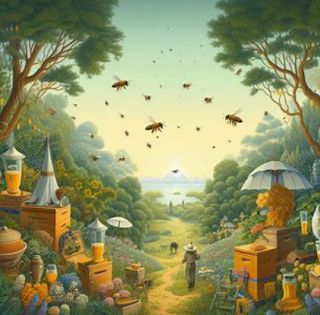A Journey Into the World of Beekeeping: Balancing Science, Care, and a Dash of Luck
For beekeepers, the buzz of spring and summer brings a flurry of activity and anticipation. This fascinating journey combines science, luck, and a deep trust in the intricate world of bees. Let's delve into the life of Jacksonville beekeeper, Gary Glaenzer, who has been tending to these tiny marvels since he was just 12 years old.
The Beekeeper's Odyssey
Gary's fascination with bees began under the mentorship of a fellow bee enthusiast when he joined 4-H. He embarked on his journey with just one hive, but today, he proudly oversees 55 hives throughout Morgan County. His remarkable journey has taught him many lessons about bee behavior, including the fact that bees won't sting if left undisturbed.
The Nectar Harvest
In Jacksonville, the bees start their nectar-gathering missions as early as late February or early March, continuing until October, depending on the weather. Gary was even able to collect honeycomb as late as early October this year, thanks to the extended warmer temperatures.
But the honey-making process is no small feat. It takes a bustling hive of 12,000 to 15,000 bees, which can swell to 60,000 to 70,000 at its peak, depending on the Queen Bee's strength. On average, each hive produces 48 to 60 pounds of honey annually, although this figure varies by year.
The Hive Hierarchy
Inside a hive, each bee has a unique role. The Queen Bee reigns supreme, laying eggs and regulating hive activity, while her pheromones give the hive its distinctive scent. Drones assist in reproduction, making up 10% to 15% of the hive but not surviving winter. The bulk of the hive's population, about 80% to 99%, consists of worker bees, responsible for various tasks, from gathering pollen and nectar to building honeycomb.
From Pollen to Honey
The process of turning nectar into honey is a true marvel. Bees collect nectar and pollen from the surroundings, depositing it into honeycomb cells. Inside the hive, they use their wings to create airflow, drying the moisture from the nectar and adding enzymes to transform it into honey. Once the process is complete, the cells are sealed with wax, preserving the golden nectar within.
The Beekeeper's Role
While bees tend to their hive's needs, beekeepers like Gary play a vital role in protecting these essential pollinators. Gary occasionally treats his hives to prevent mites from infesting and killing his bees. He also safeguards against small hive beetles, which can devastate honey stores.
From Hive to Market
When the time is right, Gary harvests the honeycomb, removes the wax cappings, extracts the honey, and strains it. He doesn't alter the honey; it's pure, natural goodness. At the market, customers may notice that honey comes in different colors and flavors, influenced by the plants bees visit.
Despite the challenges and occasional stings, Gary appreciates the satisfaction of his beekeeping journey. It's a journey filled with scientific wonder, care, and a touch of serendipity. Beekeeping, he notes, often boils down to being in the right place at the right time and a dose of good fortune.
#BeekeepingJourney, #TheLifeOfBees, #HoneyHarvest, #BeekeepersTale, #JacksonvilleBees, #HiveHierarchy, #FromHiveToMarket, #BeekeepingPassion, #NatureLovers, #SustainableLiving

